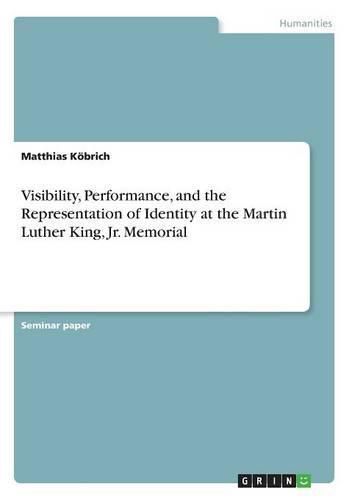Readings Newsletter
Become a Readings Member to make your shopping experience even easier.
Sign in or sign up for free!
You’re not far away from qualifying for FREE standard shipping within Australia
You’ve qualified for FREE standard shipping within Australia
The cart is loading…






Seminar paper from the year 2016 in the subject Sociology - Culture, Technology, Peoples / Nations, grade: 1.3, Friedrich-Alexander University Erlangen-Nuremberg (American Studies), course: American Cultures of Memory, language: English, abstract: The Martin Luther King, Jr. Memorial, which, since 2011, is located in the southwest of the National Mall in Washington D.C., was designed and built by Chinese sculptor Lei Yixin. It commemorates the civil rights activist that was murdered in 1968, the history of the civil rights movement of Afro-Americans, as well as the issues the movement dealt with and propagated. It was, like many other memorials throughout the USA, also subject to criticism, regarding its design, layout, material, expressiveness, the choice of its creator, and thus also its overall ‘Americanness’. In this paper, the focus will be on the questions of how this memorial works and why it works in a specific way. A memorial can serve many different purposes, such as to grieve, remember, recognize, celebrate, support, help to forget, heal, confront, equalize, understand, educate, acknowledge, etc. It will be argued that memorials are not only about the physical site, the monument or the venue in general, they are also to a huge extent about a number of external or complementary factors, such as the visitors or spectators of the site in question, and their respective performances with regard to the site of memory. Thus, a memorial never has a fixed meaning or message - to a certain extent, a memorial is always a floating signifier with meanings in constant flux, depending on its current social environment and various power relations. The visibility and interpretation of such ‘lieux des memoire’ is of course also heavily dependent on contemporary discourses, as well as individual and national identity. The terms identity, performance, visibility, and the site’s ‘Americanness’, or in other words, what the
$9.00 standard shipping within Australia
FREE standard shipping within Australia for orders over $100.00
Express & International shipping calculated at checkout
Seminar paper from the year 2016 in the subject Sociology - Culture, Technology, Peoples / Nations, grade: 1.3, Friedrich-Alexander University Erlangen-Nuremberg (American Studies), course: American Cultures of Memory, language: English, abstract: The Martin Luther King, Jr. Memorial, which, since 2011, is located in the southwest of the National Mall in Washington D.C., was designed and built by Chinese sculptor Lei Yixin. It commemorates the civil rights activist that was murdered in 1968, the history of the civil rights movement of Afro-Americans, as well as the issues the movement dealt with and propagated. It was, like many other memorials throughout the USA, also subject to criticism, regarding its design, layout, material, expressiveness, the choice of its creator, and thus also its overall ‘Americanness’. In this paper, the focus will be on the questions of how this memorial works and why it works in a specific way. A memorial can serve many different purposes, such as to grieve, remember, recognize, celebrate, support, help to forget, heal, confront, equalize, understand, educate, acknowledge, etc. It will be argued that memorials are not only about the physical site, the monument or the venue in general, they are also to a huge extent about a number of external or complementary factors, such as the visitors or spectators of the site in question, and their respective performances with regard to the site of memory. Thus, a memorial never has a fixed meaning or message - to a certain extent, a memorial is always a floating signifier with meanings in constant flux, depending on its current social environment and various power relations. The visibility and interpretation of such ‘lieux des memoire’ is of course also heavily dependent on contemporary discourses, as well as individual and national identity. The terms identity, performance, visibility, and the site’s ‘Americanness’, or in other words, what the